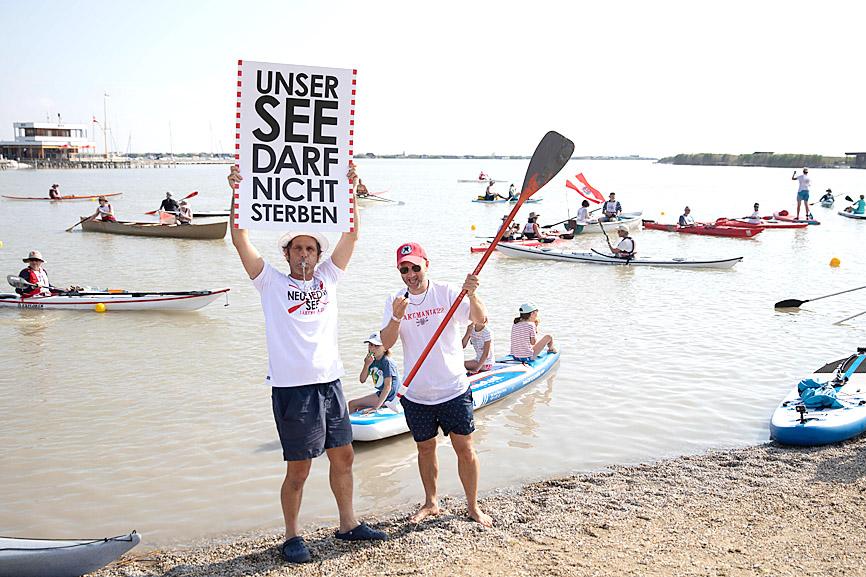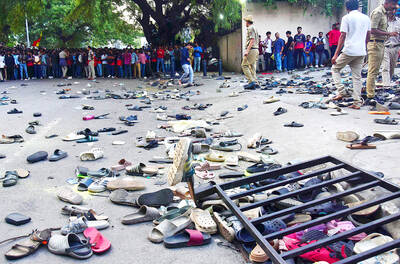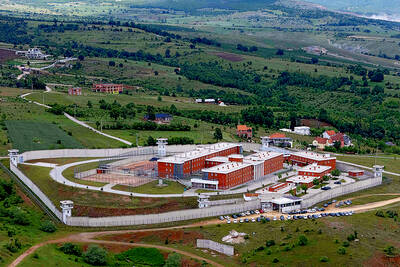Kitesurfers and windsurfers dot picturesque Lake Neusiedl on the Austrian-Hungarian border, but the water is so low some get stuck in the mud.
The salt lake and its marshes — the largest of its kind in Europe and a UNESCO World Heritage Site — could soon run completely dry, and locals are worried.
The lake, only an hour from Vienna, last dried up in the 1860s, but was naturally replenished by rainwater.

Photo: AFP
However, it was not drawing millions of tourists back then, nor was the area producing 108,862 tonnes of crops a year.
“Letting the lake and the region run dry is not an option,” Burgenland Provincial Councilor Heinrich Dorner said.
To avert what he sees as an economic disaster, Dorner is banking on a series of major projects, the biggest being a canal to bring fresh water from the Danube River in Hungary.
However, the plans have run into opposition from environmentalists, who fear any interference could accelerate the demise of the lake, the westernmost outpost of the great Eurasian Steppe.
Hungary has tasked a company owned by one of its richest men, Lorinc Meszaros, with building the canal, although work has not yet started, a municipal official said, speaking on condition of anonymity.
Meszaros, who is close to Hungarian Prime Minister Viktor Orban, is already in charge of a vast real-estate project on the Hungarian side of the lake, including the construction of a marina, sports complex and a hotel.
However, activists are against both on environmental grounds and over fears of corruption.
“The canal project is unacceptable... [and will] destroy the whole ecosystem” of the lake region, said Katalin Rodics of Greenpeace Hungary.
While other lakes naturally fill up over thousands of years, shallow Lake Neusiedl — which Hungarians call Ferto — naturally dries up about once a century. As its salty bed is exposed to saline-loving bacteria, algae, plankton and mud decompose, dry out and are swept away by the wind.
If fresh water from the Danube ends up being flushed into the lake, this could dilute the saline levels and stop the natural process, WWF biodiversity program leader Bernhard Kohler said.
“It’s a natural cycle,” Kohler said. “We’ll just have to learn to live with it again.”
However, Dorner said this is not an option.
As well as the canal, he hopes to dredge out 1 million cubic meters of mud to deepen the lake for boating.
Farmers would also have to switch from water-intensive crops such as potatoes, corn and soy, and instead plant spelt, millet or other crops more suitable for arid climates, or even wine as world-renowned grapes already grow in the sandy banks of the salt marshes, Dorner said.
The last time Lake Neusiedl dried up in the 1860s, it left an almost apocalyptic landscape. Historians described dusty clouds of salt inflaming people’s eyes, piling up on fields and spoiling crops.
Fish, too, died, and locals “lamented that they’ll starve if the dry spell of the lake continues,” but three years later, the water began its miraculous return.
However, with tributaries now cut off and more people depending on the lake than ever before, there is doubt about how long a recovery would take.
Rain, the lake’s lifeline, now increasingly falls in summer, when it evaporates faster, as overall temperatures have risen and heatwaves have increased because of climate change.
Provincial water management head Christian Sailer said it was vital to save the “very complex region.”
“The climate is changing, and that negatively affects the lake,” he said.
Last month more than 100 canoeists and rowers staged a rally on the lake to sound the alarm, some holding posters reading: “Our lake must not die.”
However, it is not just the lake that is vanishing.
More than 100 salt marshes once dotted the region, but as groundwater levels have dropped dramatically, about 60 are now “irreversibly lost,” Lake Neusiedl-Seewinkel National Park director Johannes Ehrenfeldner said.
Many of the 350 species bird watchers observe depend on these salty ecosystems, and if they dry up, “bird numbers will dwindle,” Ehrenfeldner said, his binoculars trained at a black-and-white avocet scooping tiny crabs from the mud.
“We’re running toward our own demise with our eyes wide open,” he added.

Packed crowds in India celebrating their cricket team’s victory ended in a deadly stampede on Wednesday, with 11 mainly young fans crushed to death, the local state’s chief minister said. Joyous cricket fans had come out to celebrate and welcome home their heroes, Royal Challengers Bengaluru, after they beat Punjab Kings in a roller-coaster Indian Premier League (IPL) cricket final on Tuesday night. However, the euphoria of the vast crowds in the southern tech city of Bengaluru ended in disaster, with Indian Prime Minister Narendra calling it “absolutely heartrending.” Karnataka Chief Minister Siddaramaiah said most of the deceased are young, with 11 dead

By 2027, Denmark would relocate its foreign convicts to a prison in Kosovo under a 200-million-euro (US$228.6 million) agreement that has raised concerns among non-governmental organizations (NGOs) and residents, but which could serve as a model for the rest of the EU. The agreement, reached in 2022 and ratified by Kosovar lawmakers last year, provides for the reception of up to 300 foreign prisoners sentenced in Denmark. They must not have been convicted of terrorism or war crimes, or have a mental condition or terminal disease. Once their sentence is completed in Kosovan, they would be deported to their home country. In

Brazil, the world’s largest Roman Catholic country, saw its Catholic population decline further in 2022, while evangelical Christians and those with no religion continued to rise, census data released on Friday by the Brazilian Institute of Geography and Statistics (IBGE) showed. The census indicated that Brazil had 100.2 million Roman Catholics in 2022, accounting for 56.7 percent of the population, down from 65.1 percent or 105.4 million recorded in the 2010 census. Meanwhile, the share of evangelical Christians rose to 26.9 percent last year, up from 21.6 percent in 2010, adding 12 million followers to reach 47.4 million — the highest figure

LOST CONTACT: The mission carried payloads from Japan, the US and Taiwan’s National Central University, including a deep space radiation probe, ispace said Japanese company ispace said its uncrewed moon lander likely crashed onto the moon’s surface during its lunar touchdown attempt yesterday, marking another failure two years after its unsuccessful inaugural mission. Tokyo-based ispace had hoped to join US firms Intuitive Machines and Firefly Aerospace as companies that have accomplished commercial landings amid a global race for the moon, which includes state-run missions from China and India. A successful mission would have made ispace the first company outside the US to achieve a moon landing. Resilience, ispace’s second lunar lander, could not decelerate fast enough as it approached the moon, and the company has